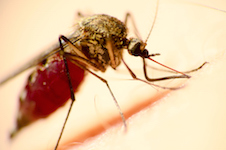
Zika Virus Structure Revealed by Researchers
April 6, 2016| |
 A team of researchers from Purdue University led by Richard Kuhn, director of the Purdue Institute for Inflammation, Immunology and Infectious Diseases (PI4D), with Michael Rossmann, Purdue's Hanley Distinguished Professor of Biological Sciences has determined the structure of the Zika virus, which reveals insights critical to the development of effective antiviral treatments and vaccines. The research team identified regions within the Zika virus structure where it differs from other flaviviruses.
A team of researchers from Purdue University led by Richard Kuhn, director of the Purdue Institute for Inflammation, Immunology and Infectious Diseases (PI4D), with Michael Rossmann, Purdue's Hanley Distinguished Professor of Biological Sciences has determined the structure of the Zika virus, which reveals insights critical to the development of effective antiviral treatments and vaccines. The research team identified regions within the Zika virus structure where it differs from other flaviviruses.
They found that all of the known flavivirus structures differ in the amino acids that surround a glycosylation site in the virus shell. The shell is made up of 180 copies of two different proteins. The glycosylation site where Zika virus differs from other flaviviruses protrudes from the surface of the virus. In many other viruses, it has been shown that as the virus projects a glycosylation site outward, an attachment receptor molecule on the surface of a human cell recognizes the sugars and binds to them. The virus is like a menacing stranger luring an unsuspecting victim with the offer of sweet candy. The human cell gladly reaches out for the treat and then is caught by the virus, which, once attached, may initiate infection of that cell.
The team studied a Zika virus strain isolated from a patient infected during the French Polynesia epidemic and determined the structure to 3.8Å. At this near-atomic resolution, key features of the virus structure can be seen and groups of atoms that form specific chemical entities, such as those that represent one of 20 naturally occurring amino acids, can be recognized, according to Rossmann.
For more details, read the news release at Purdue University website.
| |
Biotech Updates is a weekly newsletter of ISAAA, a not-for-profit organization. It is distributed for free to over 22,000 subscribers worldwide to inform them about the key developments in biosciences, especially in biotechnology. Your support will help us in our mission to feed the world with knowledge. You can help by donating as little as $10.
-
See more articles:
-
News from Around the World
- New Global Food Policy Report Says How We Feed the World is Unsustainable
- African Stakeholders Study Tour Strengthens India-African Collaboration in Cotton and Textile Sector
- Purdue University Innovation to Help Crops Survive Long Drought
- Rice can Borrow Stronger Immunity from Other Plants
- Scientists Turn to Ancient Wheat Genes to Ensure the Crop's Future
- Key Regulator of Flower Head Development in Rice Discovered
- Australian OGTR Issues License for Commercial Release of Herbicide Tolerant GM Canola
- In Biotech Breakthrough, Scientists Discover Reverse Photosynthesis
-
Research Highlights
- Bitter Orange PtrA/NINV Gene Confers Tolerance to Multiple Abiotic Stresses
- Secretion of the Bacterial Phytase by Transgenic Arabidopsis Increases Phosphate Acquisition
- MdcyMDH Overexpression Enhances Stress Tolerance in Apple
-
Beyond Crop Biotech
- International Consortium Sequence Mosquito Sex Chromosome
- Researchers Develop Programming Language for Living Cells
- Zika Virus Structure Revealed by Researchers
-
Announcements
- Himmelfahrtstagung: New Frontiers for Biotech-Processes
-
Read the latest: - Biotech Updates (January 14, 2026)
- Gene Editing Supplement (December 17, 2025)
- Gene Drive Supplement (February 22, 2023)
-
Subscribe to BU: - Share
- Tweet
